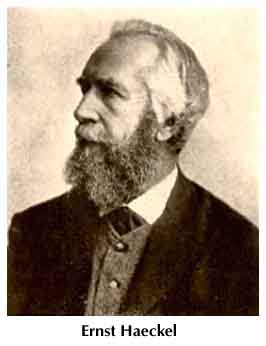

read the first, second
and third A Note from Germany - read the German version
A Brief Discussion of the Development of Menstruation and
Menstrual Hygiene
As there is a big market for menstrual hygiene products in Europe and
because of the tremendous variety of different articles, brands and manufacturers
with long histories, and also because of the immense wealth of material
I have collected I intend to give this series of articles as far as possible
a chronological order.
But for a better understanding of menstrual hygiene's history and today's
market and advertising policy, I'd like to talk a little about the evolutionary
history of menstruation and the origins of the menstrual taboo.
First, some anthropology.
It can be assumed that our ancestors (starting with Homo erectus and
Homo habilis down to the primates) did menstruate.
As we know today, human beings and apes probably have one common origin.
In 1890 Emil Selenka wrote about the identity of anthropoid and human
placental development.
 And in 1899, Ernst Haeckel, professor at the University of Jena, Germany,
noticed that among all mammals the apes have the most human-like build.
And in 1899, Ernst Haeckel, professor at the University of Jena, Germany,
noticed that among all mammals the apes have the most human-like build.
The two wombs that are characteristic for prosimians and all other mammals
are fused to one uterus in apes as well as with human beings.
We could visualize that this similarity also applies to behavior, sense
functions, "spiritual" life and brood care.
Sexually mature females of many ape species, especially of anthropoids
(orangutans, gibbons, gorillas and chimps), do have a periodical "passing
of blood out of the womb corresponding to women's menstruation.
NOTES:
Emil Selenka (1842-1902), professor of zoology and comparative anatomy
Ernst Haeckel, (1834-1919), professor of zoology at the University of
Jena, Germany, popularized Darwin's doctrines in the German-speaking world
and improves them together with the British biologist Thomas Huxley to the
doctrine of evolution respectively of development and ancestry; made up
the "basic" rules of biogenetics.
REFERENCES:
Haeckel, Ernst, "Die Welträtsel," 1899
If you have questions about menstruation or menstrual hygiene, don't
hesitate to contact me via e-mail.
First Page
| Newest News | FAQs | Directory
Take a short tour of MUM! (and
on Web video!) - FAQ - Tampon Safety Act - Visit or contact the actual museum - Board
of Directors - Norwegian menstruation exhibit
- The media and the MUM - Menstrual odor
- Prof. Mack C. Padd: Fat Cat -
The science and medicine of menstruation - Early
tampons - Books about
menstruation - Menstrual cups: history, comments - Letters - Links
© 1998 Harry Finley. It is illegal
to reproduce or distribute work on this Web site in any manner or medium
without written permission of the author. Please report suspected violations
to hfinley@mum.org




 And in 1899, Ernst Haeckel, professor at the University of Jena, Germany,
noticed that among all mammals the apes have the most human-like build.
And in 1899, Ernst Haeckel, professor at the University of Jena, Germany,
noticed that among all mammals the apes have the most human-like build.